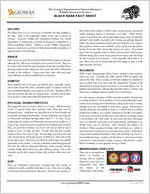The Georgia Department of Natural Resources Wildlife Resources Division
BLACK BEAR FACT SHEET
HISTORY The Black Bear (Ursus americanus) symbolizes the wild qualities of the state. Prior to the eighteenth century, bears were common in Georgia. However, habitat loss, unrestricted hunting, and overall degradation of habitat due to human development contributed to a serious population decline. Thanks to sound wildlife management practices, bears have recovered to their present healthy population of approximately 5,100 statewide.
RANGE Black bears can typically be found in three distinct regions in Georgia, although they will range over larger areas in search of food. They can be found in the North Georgia mountains, along the Ocmulgee River drainage system in the central part of the state and in the Okefenokee Swamp in the southeast. Young male bears often will roam large areas until they are able to establish their own territory.
HABITAT Bears typically live in swamps and forested areas, especially mature mixed pine stands that offer a plentiful supply of natural foods and trees and thickets that they can escape to for security. Standing, hollow trees are common den sites for Georgia bears. However, brush piles, rock crevices or other places that offer protection may be used.
PHYSICAL CHARACTERISTICS The typical life span of a bear is about 8 to 15 years. Wild bears tend to live 23 percent longer than "garbage" bears (those that exist on unnatural foods). Adult bears are generally up to six feet in length and about three feet high at the shoulder. Female adult bears can weigh up to 300 pounds and attain breeding status about 3.5 - 4.5 years of age. Adult males can weigh over 500 pounds and may breed as early as 1.5 years of age. Bears have poor eyesight but an excellent sense of smell. They are good tree climbers, can swim well and are able to run at speeds of up to 30 miles per hour. Female bears become sexually mature at two to five years of age. The breeding season is in July and cubs are born in the den in late January or February. Bear cubs weigh about eight ounces when born, are relatively undeveloped and entirely dependent on the mother. Cubs stay with their mother throughout the first year, den with her during the following winter and stay with her until she finally drives them away the following spring. Due to this extended care for their young, females only produce a litter every two years.
DIET Bears are considered omnivorous, meaning their diet consists of whatever is readily available at that time of year. Diets vary according to what part of the state the bear calls home. However, the majority of
their natural diet consists of berries, fruits, acorns, grasses and animal matter, including insects or mammals--even deer. When houses, camps or recreation areas are located within range, bears are naturally attracted to the smells associated with cooking and garbage disposal. Other non-natural attractants include pet food, birdseed, suet, compost piles, gardens, beehives and cornfields. Bears can become attracted to human food when their natural diet sources are scarce. Non-natural type foods are typically easier to obtain and associated with humans, therefore luring bears away from natural food sources and dissolving the bear's natural fear of humans. A bear typically will remain in an area where food can be found until that food supply is gone or until other measures are taken.
NUISANCE WRD Game Management offices receive numerous bear nuisance calls every year. Typically, the caller expects WRD to capture and relocate the bear. This is usually not the best solution for residents or bears as other bears may move into the "abandoned" territory or the relocated bear, trying to find its way back, is commonly hit by a car. In addition, relocated bears will typically enter into territory conflicts with other bears, resulting in injury or death of one or both bears.
For each nuisance situation, a WRD associate evaluates why the bear is causing problems. Most problems can be resolved through simple actions such as taking down bird feeders, taking in pet food, or storing garbage in an area unavailable to bears like a garage. Removing or making attractants unavailable to bears is a critical step in resolving bear/human conflicts. It is equally important for people to be patient. It may take several days for the bear to learn that it is no longer going to be provided with a free meal. In most cases, the bear will simply move on when the food source is no longer present. Installation of an electric fence may be necessary when beeyards and gardens are involved. When camping or hiking, store food items in a vehicle or hoist food packs into the air away from the trunks of trees. If left alone, young bears searching for territory will usually find their way back to a more traditional range. Capture and relocation is a last resort and only warranted if a bear persists in being a nuisance and presents a safety threat to residents or major property damage is likely.
BEAR/HUMAN CONFLICTS There are no recorded bear attacks on humans in Georgia, and no fatalities. There have only been two documented fatal black bear attacks in the Southeastern United States.
www.georgiawildlife.com
Revised April 2010
